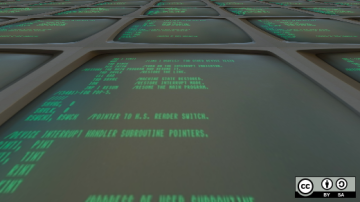The pushd and popd commands are built-in features of the Bash shell to help you "bookmark" directories for quick navigation between locations on your hard drive. You might already feel that the terminal is an impossibly fast way to navigate your computer; in just a few key presses, you can go anywhere on your hard drive, attached storage, or network share. But that speed can break down when you find yourself going back and forth between directories, or when you get "lost" within your filesystem. Those are precisely the problems pushd and popd can help you solve.
pushd
At its most basic, pushd is a lot like cd. It takes you from one directory to another. Assume you have a directory called one, which contains a subdirectory called two, which contains a subdirectory called three, and so on. If your current working directory is one, then you can move to two or three or anywhere with the cd command:
$ pwd
one
$ cd two/three
$ pwd
threeYou can do the same with pushd:
$ pwd
one
$ pushd two/three
~/one/two/three ~/one
$ pwd
threeThe end result of pushd is the same as cd, but there's an additional intermediate result: pushd echos your destination directory and your point of origin. This is your directory stack, and it is what makes pushd unique.
Stacks
A stack, in computer terminology, refers to a collection of elements. In the context of this command, the elements are directories you have recently visited by using the pushd command. You can think of it as a history or a breadcrumb trail.
You can move all over your filesystem with pushd; each time, your previous and new locations are added to the stack:
$ pushd four
~/one/two/three/four ~/one/two/three ~/one
$ pushd five
~/one/two/three/four/five ~/one/two/three/four ~/one/two/three ~/oneNavigating the stack
Once you've built up a stack, you can use it as a collection of bookmarks or fast-travel waypoints. For instance, assume that during a session you're doing a lot of work within the ~/one/two/three/four/five directory structure of this example. You know you've been to one recently, but you can't remember where it's located in your pushd stack. You can view your stack with the +0 (that's a plus sign followed by a zero) argument, which tells pushd not to change to any directory in your stack, but also prompts pushd to echo your current stack:
$ pushd +0
~/one/two/three/four ~/one/two/three ~/one ~/one/two/three/four/fiveAlternatively, you can view the stack with the dirs command, and you can see the index number for each directory by using the -v option:
$ dirs -v
0 ~/one/two/three/four
1 ~/one/two/three
2 ~/one
3 ~/one/two/three/four/fiveThe first entry in your stack is your current location. You can confirm that with pwd as usual:
$ pwd
~/one/two/three/fourStarting at 0 (your current location and the first entry of your stack), the second element in your stack is ~/one, which is your desired destination. You can move forward in your stack using the +2 option:
$ pushd +2
~/one ~/one/two/three/four/five ~/one/two/three/four ~/one/two/three
$ pwd
~/oneThis changes your working directory to ~/one and also has shifted the stack so that your new location is at the front.
You can also move backward in your stack. For instance, to quickly get to ~/one/two/three given the example output, you can move back by one, keeping in mind that pushd starts with 0:
$ pushd -0
~/one/two/three ~/one ~/one/two/three/four/five ~/one/two/three/fourAdding to the stack
You can continue to navigate your stack in this way, and it will remain a static listing of your recently visited directories. If you want to add a directory, just provide the directory's path. If a directory is new to the stack, it's added to the list just as you'd expect:
$ pushd /tmp
/tmp ~/one/two/three ~/one ~/one/two/three/four/five ~/one/two/three/fourBut if it already exists in the stack, it's added a second time:
$ pushd ~/one
~/one /tmp ~/one/two/three ~/one ~/one/two/three/four/five ~/one/two/three/fourWhile the stack is often used as a list of directories you want quick access to, it is really a true history of where you've been. If you don't want a directory added redundantly to the stack, you must use the +N and -N notation.
Removing directories from the stack
Your stack is, obviously, not immutable. You can add to it with pushd or remove items from it with popd.
For instance, assume you have just used pushd to add ~/one to your stack, making ~/one your current working directory. To remove the first (or "zeroeth," if you prefer) element:
$ pwd
~/one
$ popd +0
/tmp ~/one/two/three ~/one ~/one/two/three/four/five ~/one/two/three/four
$ pwd
~/oneOf course, you can remove any element, starting your count at 0:
$ pwd ~/one
$ popd +2
/tmp ~/one/two/three ~/one/two/three/four/five ~/one/two/three/four
$ pwd ~/oneYou can also use popd from the back of your stack, again starting with 0. For example, to remove the final directory from your stack:
$ popd -0
/tmp ~/one/two/three ~/one/two/three/four/fiveWhen used like this, popd does not change your working directory. It only manipulates your stack.
Navigating with popd
The default behavior of popd, given no arguments, is to remove the first (zeroeth) item from your stack and make the next item your current working directory.
This is most useful as a quick-change command, when you are, for instance, working in two different directories and just need to duck away for a moment to some other location. You don't have to think about your directory stack if you don't need an elaborate history:
$ pwd
~/one
$ pushd ~/one/two/three/four/five
$ popd
$ pwd
~/oneYou're also not required to use pushd and popd in rapid succession. If you use pushd to visit a different location, then get distracted for three hours chasing down a bug or doing research, you'll find your directory stack patiently waiting (unless you've ended your terminal session):
$ pwd ~/one
$ pushd /tmp
$ cd {/etc,/var,/usr}; sleep 2001
[...]
$ popd
$ pwd
~/onePushd and popd in the real world
The pushd and popd commands are surprisingly useful. Once you learn them, you'll find excuses to put them to good use, and you'll get familiar with the concept of the directory stack. Getting comfortable with pushd was what helped me understand git stash, which is entirely unrelated to pushd but similar in conceptual intangibility.
Using pushd and popd in shell scripts can be tempting, but generally, it's probably best to avoid them. They aren't portable outside of Bash and Zsh, and they can be obtuse when you're re-reading a script (pushd +3 is less clear than cd $HOME/$DIR/$TMP or similar).
Aside from these warnings, if you're a regular Bash or Zsh user, then you can and should try pushd and popd.








7 Comments